
alne),a continuing balance-of-payments deficit of the type usually discussed in balance-of- payments theory ultimately requires credit creation to keep it going.This in tum implies that either of two causes:too low a ratio of international reserves relative to the domestic money supply,so that the mic policy relyon the natural by credit creation.In both cases,the problem is associated fundamentally with the power of tin banking systemstocreate money which acceptable backing Toconclude that balance-of-payments problems are ssentially moneary is notofoure to assert that they are attributable to monetary mismanagement-they may be,or they may be "eal"forces in the face of which the playa.The conclusion does mean,however,that the distinctions which have sometimes been drawn between monetary and real disequilibria,for example by conepts not logically valid-though such,carefully used,may be helpful in isolating the initiating causes of disequilibriumor the most appropriate type of remedial policy to follow. Formulation of the balance of payments as the difference between aggregate payments and aggregate receipts thus illuminates the monetary aspects of balance-of-paym nts disequilibrium, which this approach sheds on the policy problem of oorrecting a deficit,by relating the balance of payments to the overall operation of the economy rather than treating it as one sector of the eomy to be analysed by itsel An excess of aggregate payments by residents over aggregate receipts by residents is the taker by the community of residents considered as a group (excluding,as always,the foreign exchange authority)though itmust be gied that this technique ignores many of the complications that would have to be investigated in a more detailed analysis. Two sorts of aggregate decision leading to a balance-of-payments deficit mav be "stock"decisions and "flow"decisions:a (stock)decision to alter the composition of the community's assets by substituting other assets for domestic money,and a(flow)decision to spend currently in excs of current receipts.Since both real goods and securitiesar assets to domestic money,and current expenditure may consist in the purchase of either goods ,the balane-of-payment type decision ①With the cor nity defined to include ther teefietdwawinsse

may show itselfon either currentor capitalacount.That is,a current acount deficit may reflect either a community decision to shift out of cash balances into stocks of goods,oa decision to use goods in excess of the community's current rate of production,while a capital account deficit may reflect either a decision to shift out of domestic money into securities or a decision to lend in excess of the current rate of saving. The distinction between"stock"and"flow"balance-of-payments deficits is important for both theory and practical policy,though refincd theoretical analysis has generally been concered,without making the distinction explicit.The importance of the distinction stems from the fact that a"stock"deficit is inherently temporary and implies no real woreningof the country'smi psition,whereasa"flowdeficit is not inherenty temporary and may imply a worsening of the country's economic position. Since a stock decision entails a once-for-all change in the composition of a given aggregate capital assets,a"must necessarily be a temporary in itsfit implies no deterioration (but rather the reverse)in the country's economic position and methods available are familiar.but it may be useful to review them briefly in relation to the framework of analysis developed here Todiscourage the of stcks of goods for domestie them policy authorities may either raise the cost of stock-holding by credit restrictions or reduce its by depreciation.Under both policies,the magnitude of the effectis uncertain-depreciation,by stimulating destabilizing expectations,may even promot stock accumulation-while unavoidable repercussions on the fow equilibrium of the economy are se up.These considerations argument for the usof tbe methodof direct oontrols on stock-holding,an indirect and partial form of which is quantitative import restriction. Todisoourage the substitution of securities for domestic curency,the same bro alternatives are available:credit restriction,which amounts to the monetary authority substituting domestic currency for securities substitution of securities for domestic currency by the rest of the commnity:devaluation,which affects the that the fscto the char the na must be de ce of pev This ed mo in o n with imp 8

sccurities only through expectations and may work either way;and exchange controls restricting the acquisition of securities from abroad.Considerations similar to those of the previous paragraph would sem to argue in favour of the use capita In both cases,evaluation of the policy alternatives suggests the use of control rather than price system methods.It should be recalled,though,that the problem is created by the assumed inadequacy of the country's international reserves.In the longer run,the choice for eomic policy lies.not between the three alteratives discused,but between the necessityof having between them and the in the accumulation of large enough to finance potential "stock"deficits.Also,nothing has been said about the practical difficulties of maintaining effectiveonover interationa trasctopcially capital movements. 【n contrast to a“stock"deficit,a“flow”deficit is not inherently of limited duration.lt will be if the monetary authority is not prepared but this is because its existence will then set up monetary repercussions which will eventually alter the collective decision responsible for it,not because the initial decision implied a temporary deficit.If the interest rates,it follows that the terination of a"ow"deficit requires a deliberate change of econmic policy.Further,a"flow"deficit may imply a worsening of the ountry's capital position,providing an eonomic as well as a monetary incentive to terminate the diqim.② Inanalysing the policy problems posed by "flow"deficits,it is convenient to begin by abstracting altogetherfrom inteational capital movements (other than reserve transactions between foreign exchange authorities)and considering thecasofaceoun deficit.In this case.if intermediate transactions are excuded,the balance of payments becomes the difference between the value of the country's output (its national income)and its total expenditure.ie. B=Y-E. To facilitate analysis by avoiding certain complications associated with the possibility of changes in the omestic price and being vaed domestic output.A deficit then consists in an excess of real expenditure over real income.and the problem a deficit is to bring real nationl income (output)and real nationa This a which is slightly ino gadrfiamriotohe s the tion may be f urable:if it addition increase productive capacity 9

This formulation suggests that policies for correcting current-account deficits can be classified broadly into two types:those which aim at (or rely on)increasing output,and those of the policy,since income and expenditure are interdependent:expenditure depends on and varies with income,and income depends on and varies with expenditure (because part of expenditure isdevoted tohome-produced any change in me or expenditure will initiate multiplier changes in both.It can,however,readily be shown that,so long as an increase in income induces a smaller change in aggregate expenditure,the multiplier repercussions will not be large the impact effect ofachange .so that an impect increase in output or decrease in expenditure will always improve the balance on current The distinction b eenouput-ncreasing and plic may usfuly be put in another way.Since output is governed by the demand for it,a change in output can only be brought about by a change in the demand for it;a policy of incrensing domestic output expenditure(either foreign or domestic)on that ouput Given the level of expenditure,this in tur involves effecting a switch of expenditure (by residents and foreigners)from foreign output to domestic output.The distinction between output-increasing and expenditure-decreasing policies,which rests on the policis may therefore be replaced by a distinction between expenditure-switching policies and expenditure-reducing policies,which rests on themethd by which the effectsare achieved. Apolicy of expenditure-reduction may be applied througha variety of means -mone restriction,budgetary policy.or even a sufficiently comprehensive battery of direct controls Since any such policy will tend to reduce income and employment,it will have an additional attr ction if the well sa balance-of-payments deficit,but a corresponding disadvantage if the oountry is suffering from unemployment. Moreover,since the impact reduction in expenditure and the total reduction in inme and a given deficit are larger the larger the proportion of the expenditure reduction falling on home-produced goods,and since different methods of expenditure-reduction ng the c o in the text, dy- (wherethereductidomestic ut).gives the result: -)dE. e+en ludes indu t液m d unity ol the text.) diture reduction will lo

may differ in this respect,the choice between alterative methods may depend on the income may lead to some reduction in the domestic price level,and/or a greater eagerness of domestic producers to compete with foreign producers both at home and abroad,expenditure- reducingpolicies mayhave incidental effects Expenditure-switching policies may be divided into two types.according to whether the policy instrument employed is general or selctive:devaluntion (which may be taken the case of a deflation-induced reduction of the domestic price level under fixed exchange rates),and trade controls (including both tariffs and subsidies and quantitative restrictions) contros are usually imposed on imports,and aim at (or have the effect of)switching domestic expenditure away from imports towards home goods,though sometimes they are used to Both types of expenditure-switching policy may have direct impuct-effects on residents expenditure.Devaluation may result in increased expenditurefrom the initial inme level, through thecedf-rade effect"ofvete-rade m ment in reducing real income and therefore the proportion of income saved.Trade controls will tend to have the same effect,via the reduction in real incme freedom of choice. In addition.trade conros must alter the real expenditure corresponding to the initial output level if they take the fomm of import duties or export subsidies uncomp nsated by other fiscal changes this eshould,however,be cse dasa combined policy of expenditure-chang (unfavourable in the case of the export subsidy)and expenditure-switch Whether nature,an expenditure-switching policy seks deficit by switching towards dom tic goods;and it depends for success not only on switching demand in the right direction,but also on the capacity of the make available the additional demand.Such policies therefore pose two problems for economic analysis:the conditions required for expenditure to be switched in the desired direction,and the source of the additional output meet the additional demand. As to the first question,the possibilities of failure for both devaluation and controls have t ith hee polcy ex d to ied Jor a shor wil b ooks th ing the r tive in u n白a to the final sent of the aph.is that if the of the tt) ne is